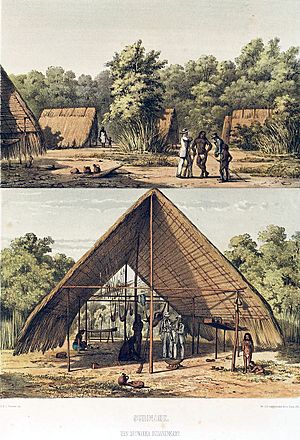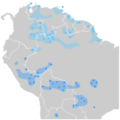Arawak facts for kids

Arawak village (1860)
|
|
| Languages | |
|---|---|
| Taíno |
The Arawak are a group of indigenous peoples from South America. They also lived historically in the Caribbean. The name "Arawak" has been used for the Lokono people of South America. It also refers to the Taíno people who lived in the Greater Antilles and northern Lesser Antilles. All these groups spoke languages related to the Arawakan languages.
Scientists believe the Arawak first settled near the Aruka River about 3,500 years ago.
Contents
Who Are the Arawak?
The name Arawak first described a group in South America. These people called themselves Arawak or Lokono. Their language, the Arawak language, gave its name to the larger Arawakan language family.
Arawakan speakers in the Caribbean were also known as the Taíno. This word means "good" or "noble." Island people used it to tell themselves apart from the nearby Island Caribs. In 1871, a scholar named Daniel Garrison Brinton suggested calling the Caribbean people "Island Arawak." This was because they shared culture and language with the mainland Arawak. Later, people shortened this to "Arawak," which caused some confusion. In the 1900s, scholars started using "Taíno" again for the Caribbean group. This helped show their unique culture and language.
Arawak History and Origins
The Arawakan languages might have started in the Orinoco River valley. From there, they spread widely across South America. By the time Europeans arrived, Arawakan was the most widespread language family. Speakers lived along the Orinoco River and Amazon River and their smaller rivers.
The group known as the Arawak or Lokono settled along the coasts. These areas are now Jamaica, Guyana, Suriname, Curaçao, French Guiana, and parts of Trinidad and Tobago.
The Taíno People of the Caribbean
At some point, the Arawakan-speaking Taíno culture grew in the Caribbean. There are two main ideas about how the Taíno ancestors arrived. One idea, the "Circum-Caribbean" model, suggests they came from the Colombian Andes. The other, the Amazonian model, says they came from the Amazon basin. This is where the Arawakan languages first developed.
The Taíno were among the first American people to meet Europeans. This happened when Christopher Columbus visited their islands on his first trip. After this, European settlement began. Sadly, the Taíno population quickly dropped. They suffered from wars, diseases, and being forced into labor. By 1519, only a few thousand Taíno were left. By the end of that century, they were no longer a separate group.
Even today, Taíno influence can still be seen. It shows up in the religions, languages, and music of Caribbean cultures.
The Lokono People's Story
The Lokono and other South American Arawak groups resisted European control for a longer time. The Spanish could not fully control them during the 1500s. In the early 1600s, the Lokono joined with the Spanish. They fought against the nearby Kalina (Caribs), who had joined with the English and Dutch.
The Lokono benefited from trading with European powers until the early 1800s. After that, their region faced economic and social changes. This included the end of the plantation economy. Their population went down until the 1900s. Then, it started to grow again.
Arawak People Today
The Taíno people stopped existing as a distinct group in the 1500s. However, many people in the Caribbean today have Taíno ancestors. A study in 2003 looked at mitochondrial DNA. It found that 62% of people in Puerto Rico have direct maternal ancestors from Taíno or Arawakan groups.
Today, there are about 10,000 Lokono people. They live mainly in the coastal areas of Venezuela, Guyana, Suriname, and French Guiana. Many more people in the region are Lokono descendants. Unlike many other indigenous groups in South America, the Lokono population is growing.
Images for kids

See also
 In Spanish: Arahuacos para niños
In Spanish: Arahuacos para niños


